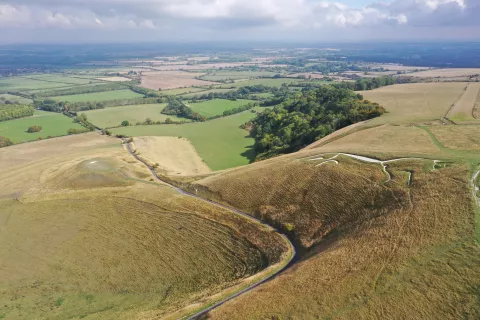The White Horse's ancient origins are not the only reason why it is so well-loved. The chalk figure is located in the parish of Uffington, Oxfordshire. It is 120 metres long and was formed by digging segmented chalk trenches into the upper slopes of the hill, sitting in a spectacular natural landscape on the dramatic scarp of the Wessex chalk Downs. Many natural features combine to create the dramatic setting: the deep plunging valley, the Manger, with its rippling sides; a flat-topped conical hill under the Horse, Dragon Hill; the panoramic view over the Vale to the Corallian Ridge, the Cotwolds and the Thames Valley beyond.
Then there are the archaeological traces of those who came before, as well as after, the Horse: the ancient Ridgeway route, running along the scarp from the hillfort to Wayland’s Smithy, a Neolithic tomb, to the west; Uffington Castle, the Iron Age hillfort above the Horse; a long mound - a Neolithic or early Bronze Age barrow reused as a Roman cemetery millennia later; Bronze Age circular barrows which were reused for burials in the Anglo-Saxon period. The Horse's remarkable, abstract shape with a distinctive ‘beaked’ head resembles images of some horses on Ancient British coins. Antiquity permeates the whole area.
The strong emotive bonds, that this rich and natural landscape evoke in us, were obviously felt as keenly by those past generations that built the Horse, and lived and were buried there. The landscape and its deep history are intertwined with local legends and customs, and tied together by the language of myth from the Germanic blacksmith god to the medieval legend of St George, who is said to have slain the dragon here.
It is incredible that such a fragile and vulnerable image should have been preserved for centuries. It has only been possible thanks to the care of local communities.




